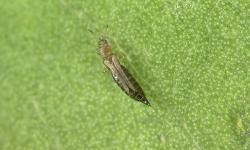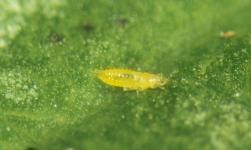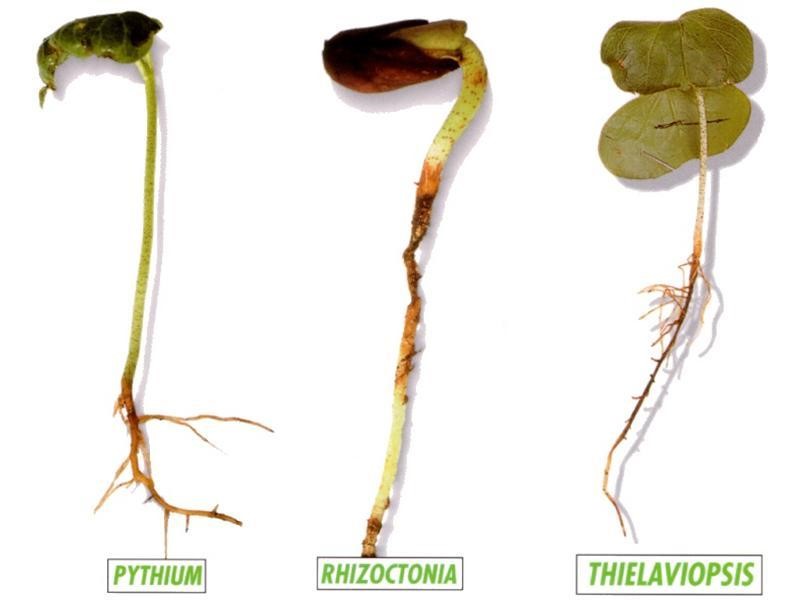By Ethan Carter
Good crop management, early in the season, can lead to a healthier, more established plant stand. Cotton plants that are free of stress are able to be more competitive in the field and have a better chance of overcoming any future issues than those already in a weakened state. Planting season is the perfect time to evaluate a field’s disease and pest history, and decide how these issues can be targeted going into a new crop year. Seed treatments, in-furrow applications, and preemergence herbicides can be used to successfully control an array of insects, soilborne diseases, and weeds.

Adult female tobacco thrips with normal wings (able to fly), there can also be a morph possessing reduced or absent wings

Tobacco thrips larva. Photograph taken by Lyle Buss, University of Florida.
Thrips: Many of the early season insecticides are applied in hopes of minimizing thrips damage in the field. Populations resistant to the neonicotinoid seed treatments are becoming an increasing threat. It has been reported in some areas that roughly 20% of populations have been found resistant to imidacloprid (i.e. Gaucho), 20% resistant to thiamethoxam (i.e. Crusier), and 40% found resistant to both. Despite this fact, seed treatments are still a worthwhile investment, as they do maintain some level of control and are active for 14-21 days after planting. Thrips feed on the cotyledons and terminal bud of plants, feeding damage can result in malformed leaves, stunting, delayed maturity, and reduced yield potential. Thrips pressure is thought to be higher for earlier plantings, but in recent years peak movement has been around mid-May. Wet planting seasons can help delay thrips movement from wild host plants to cotton fields, as those plants are kept greener for longer periods of time which prevents thrips from needing to move. In cotton, foliar sprays are recommended at the one to two true leaf stage when seedlings are not growing rapidly. Seedlings that are actively or rapidly growing can better tolerate thrips feeding damage, 3-4 leaf stage vs 2 leaf or less.
Disease: Like pests, adequate control of seedling diseases can be achieved the first few weeks after planting through the use of seed treatments and in-furrow applications. Seedling diseases are caused by a number of fungal pathogens (Pythium, Rhizoctonia, Theilaviopsis, and Fusarium) which can be present in cotton fields. Unlike thrips movement, which may be delayed in wetter years, seedling diseases prefer cooler and wetter conditions. Seed treatments can vary, some are protectant fungicides such as Thiram and Captan, verses thosewith systemic activity when absorbed from the seedling such as Vitavax and Ridomil Gold. Following the management practices outlined in the UGA Cotton Production Guide is an excellent way to minimize the risk of seedling disease outbreak in a field setting.
Good management practices to reduce the chance of disease include the following:
- Plant in warm soils where the temperature at a 4-inch depth is above 65° F and where the 5-day forecast doesn’t call for cooler or wetter weather. NOTE: Cotton growers should NOT plant cotton, if at all possible, when conditions are cool and wet, or if the forecast calls for such conditions soon after planting, even if they plan to use additional fungicide treatments!
- Plant seed on a raised bed since soil temperatures in the bed are generally slightly warmer than surrounding soil, and drainage is likely to be better. Cotton planted with conservation tillage is not grown on raised beds, thus potentially increasing the threat from seedling disease.
- Avoid planting seed too deeply. Seed that is planted too deep results in longer periods before the young seedling cracks the soil surface, increasing the likelihood of seedling disease.
- Correct soil pH with lime (pathogenic fungi are more tolerant to acidic soils than are cotton seedlings; pH should be in the range of 6.0 to 6.5).
- Fertilize according to a soil test to promote rapid seedling growth; however care should be taken to avoid “burning” the seedling with excessive rates of at-plant fertilizers
- Avoid chemical injury through the use of excessive amounts or improper application of insecticides, fungicides, or pre-plant herbicides.
- Plant only high quality seed, as indicated by the percent germination in the standard seed and cool germination tests. Preferably, cool germination test results should be above 70%, though 60-69% is still adequate.
Diseases can include seed rot, preemergence damping off, and postemergence damping off. Seed rot occurs prior to germination, resulting in decayed seed and noticeable gaps in the plant stand. Preemergence damping off also results in gaps in the stand, but in this situation the seed successfully germinated, but was killed by the pathogen before it could break the soil surface. Postemergence damping off occurs after the seedling has broken the soil surface and is identified by a lesion at or near the soil line, which will eventually expand girdling the plant. This condition is commonly referred to as ‘soreshin’ and is caused by Rhizoctonia. Many factors influence the effectiveness and infection of these pathogens including seed quality, soil moisture, soil temperatures under 65°F, soil compaction, and plant stress.

Herbicides: The application of a preplant or preemergence herbicide is an excellent way to prevent weed infestations before they begin. Early season weeds have the potential to be very competitive with the crop, mostly due to the fact that, if left unchecked, reach or surpass the crop in height. It is important to incorporate preemergence herbicides to improve their reliability, especially yellow herbicides (i.e. Prowl or Treflan). Palmer amaranth {pigweed) has become one of the most difficult weeds to control in crop fields, so it is important to start managing this weed prior to emergence, or when it is very small and easier to control. Examples of early season control tactics for palmer pigweed in cotton are mentioned in the excerpt below, for more information click the link to the full document at the bottom of the page regarding Palmer amaranth control.
Cotton
A cotton program should start with a good preplant program that includes Valor, Reflex, Direx, or Banvel/Clarity. These herbicides should provide up to 15–30 days of effective control but should still be followed by Prowl, Staple, Cotoran, or Direx at planting. Additionally, Direx + MSMA or Valor + MSMA should be used at layby to effectively control Palmer amaranth with both postemergence and soil residual activity. It must be noted that all preemergence herbicides require activation by either rainfall or irrigation. If these materials are applied and activation does not occur, no control will be realized—particularly if these herbicides were initially applied to dry soil. See Table 3 for more information.
Salvage Treatments. If Palmer amaranth has reached heights of 6″ or greater, it is not likely that any postemergence herbicide option (Staple or Liberty 280) will be effective. Depending on cotton size, a directed application may also fail to be effective. If this is the case, a hooded application may be necessary. Source: Control of Palmer Amaranth in Agronomic Crops
Pesticide use can be crop dependent, so it is important to check the label to determine what the product controls, which crops it’s labeled for, the usage rates, and other restrictions. For resistance management, it is important to rotate pesticide applications with products having different modes of action.
Source:ufl.edu